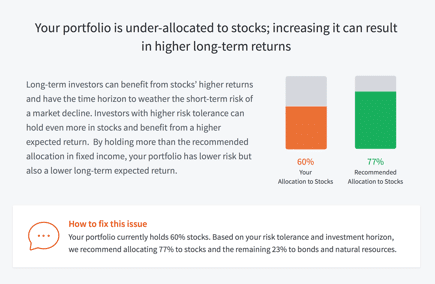One of the features that robo-advisors have been marketing to appeal to investors are low fees compared to human administrated financial advisors. In place of financial advisors that glean information from their customers and construct portfolios, robo-advisors use an automated approach.
To do this, robo-advisors create several different investment funds using ETFs and are segregated into different asset types such as bond, cash, growth stocks and low risk Equities . Customers then fill out information forms that gather investment data such as funding goals, risk tolerance, investment duration and expected deposit rates. Using this information, robo-advisors build a portfolio for their customers and allocate their investment between the firm’s group of funds. Customers with longer investment durations and higher risk tolerance will have portfolios built with higher proportions of equity exposure while the opposite will be true for risk adverse shorter term investors.
Overall, one of the advantages of automation and investing in ETFs is lower expected fees collected by customers. According to robo-advisors, the decrease in fees benefits customers over the long term as there are more funds that remain in the account that can be invested with their performance compounded.
Expense review and Fintech
Riding the wave of low fees, Wealthfront, one of the world’s largest robo-advisors, has launched a new tool, Wealthfront Portfolio Review, for investors to compare investment expenses. The product allows anyone to connect to their brokerage account and receive a review of their portfolio expenses. The tool than provides recommendations on the findings of the review.

Providing advisory services themselves, it is fair to believe that Wealthfront will aim to provide as many recommendations as possible of the solutions that they provide. However, even without recommending their own products, the new review tool is part of an emerging fintech focus on fees.
First hitting areas such as eCommerce and travel in the late 1990’s and proliferating in the early 2000’s, shopping comparison sites are staples of the internet. The comparison model has slowly shifted to other industries, with financial services becoming a growing market over the last few years. Arguably the area of greatest impact so far has been in the credit and online space, where such services have led CreditKarma to become a company valued at billions with its credit score and lender matching service.
Within the investment product space, and competing with Wealthfront’s new expense review tool, is FeeX. Connecting accounts, users share their expense data of investments such as 401Ks and IRAs. Aggregating user data, the site then provides crowdsourced fee reviews and analysis of where and how much investors are overspending on their savings plans.
Where their product becomes interesting is that beyond their consumer facing site, FeeX is also building solutions for businesses such as Registered Investment Advisors (RIA) and asset management firms. Using these solutions, companies will be able to provide similar expense review tools like that of Wealthfront, and display how their own products stack up with the competition. For an RIA building a portfolio for customers, this provides a tool to show clients how they are saving in expenses with its services.
While these solutions are in their infant stages with awareness low, history has shown that consumers have embraced internet based comparison sites. As such, while Wealthfront and other fee review services have yet to establish much awareness among the general investing public, as their use grows it is expected to lead a wider industry trend towards more debate on lower fees.

















